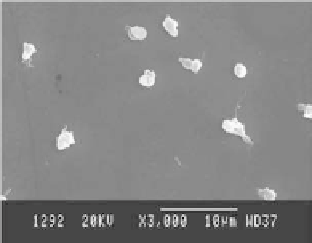Biomedical Engineering Reference
In-Depth Information
(a)
(b)
FIGURE 19.43
Morphology of adherent platelets observed by SEM on (a) LTIC (120 min incubation in
PRP) and (b) P-doped DLC (120 min incubation in PRP). (From Kwok, S.C.H. et al.,
Diam. Relat. Mater.
, 14,
78, 2005. With permission.)
changes on the different surfaces after 120 min incubation are compared. As shown in Figure 19.43,
the adherent platelets on the P-doped DLC and LTIC are isolated and relatively round.
The interfacial tension is highest with albumin on the P-doped DLC fi lm, but there are
higher interfacial tensions between fi brinogen and LTIC or DLC. This suggests that albumin
is preferentially adsorbed on P-doped DLC, whereas fi brinogen is preferentially adsorbed on
LTIC and DLC. In particular, a high contribution of polar interaction between undoped DLC
and albumin and an equal level of dispersive and polar interaction between undoped DLC and
fi brinogen further prove the preferential adsorption of fi brinogen on the undoped DLC surface.
Albumin preferential adsorption is known to passivate the surface of an implant and the prefer-
ential adsorption of fi brinogen or globulin will lead to favor coagulation and platelet activation.
Furthermore, the interfacial tensions of three kinds of plasma proteins on the P-doped DLC
surface are signifi cantly lower than those on the undoped DLC and LTIC surfaces. Moreover, a
mechanically stable blood-biomaterial interface is considered as another surface energetic cri-
terion of biocompatibility of a foreign surface [168]. Because the cellular elements are compat-
ible with blood and their interface with the medium is also mechanically stable, it is considered
that a blood-biomaterial interfacial tension of about the same magnitude as the cell-medium
interfacial tension (
γ
SL
≈
1-3 dynes/cm) will provide a foreign surface with both long-term com-
patibility as well as mechanically stable interface with blood. It has been shown that the inter-
facial tension between the P-doped DLC fi lm and medium (water) is 2.7 dynes/cm, which has
the same magnitude as the cell-medium interfacial tension. Thus, the good hemocompatibility
of the P-doped DLC coating is because it signifi cantly minimizes the interactions with plasma
protein giving rise to slight changes in the conformation of adsorbed plasma proteins and pref-
erentially adsorbed albumin.
19.5.1.4.2 Calcium-Doped DLC Films (Ca-DLC)
Calcium (Ca), the fi fth most abundant element in the earth's crust, is one of the essential elements
in living organisms particularly pertaining to cell physiology. Moreover, calcium is a crucial con-
stituent in bones and teeth formation and hence, it is an interesting dopant in DLC for biomedical
applications. In this study, three doped DLC fi lms, Ca-doped, Ca and P-doped, and P-doped DLC
fi lms, are produced.
The surface biocompatibility was assessed using
in vitro
platelet adhesion tests. Figure 19.44
displays the morphology and the quantity of the adhered platelets on the samples. The statistical
results are presented in Figure 19.45. Both the P-DLC and Ca-DLC fi lms show smaller numbers of
adhered and unactivated platelets than LTIC. The results show that either Ca or P doping alone can
enhance the hemocompatibility but not when acting together.





